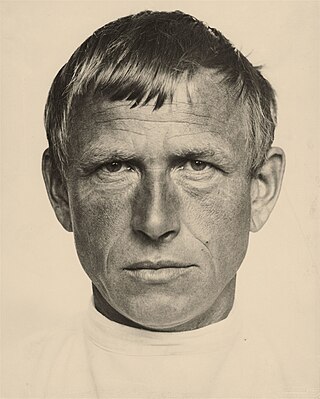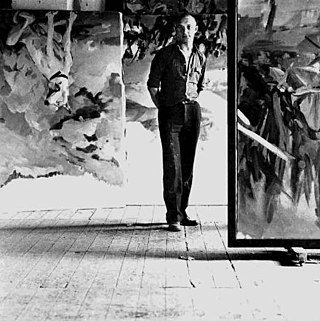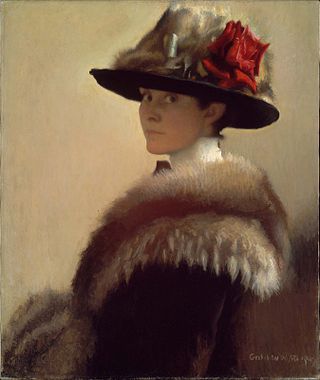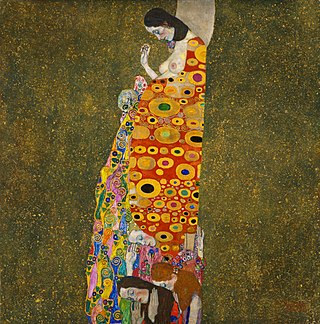Related Research Articles

Wilhelm Heinrich Otto Dix was a German painter and printmaker, noted for his ruthless and harshly realistic depictions of German society during the Weimar Republic and the brutality of war. Along with George Grosz and Max Beckmann, he is widely considered one of the most important artists of the Neue Sachlichkeit.

Georg Baselitz is a German painter, sculptor and graphic artist. In the 1960s he became well known for his figurative, expressive paintings. In 1969 he began painting his subjects upside down in an effort to overcome the representational, content-driven character of his earlier work and stress the artifice of painting. Drawing from myriad influences, including art of Soviet era illustration art, the Mannerist period and African sculptures, he developed his own, distinct artistic language.

Abraham Bloemaert was a Dutch painter and printmaker who used etching and engraving. He initially worked in the style of the "Haarlem Mannerists", but by the beginning of the 17th-century altered his style in line with the new Baroque style that was then developing. He mostly painted history subjects and some landscapes. He was an important teacher, who trained most of the Utrecht Caravaggisti.

Jan Lievens was a Dutch Golden Age painter who was associated with his close contemporary Rembrandt, a year older, in the early parts of their careers. They shared a birthplace in Leiden, training with Pieter Lastman in Amsterdam, where they shared a studio for about five years until 1631. Like Rembrandt he painted both portraits and history paintings, but unlike him Lievens' career took him away from Amsterdam to London, Antwerp, The Hague and Berlin.

Cornelis de Vos was a Flemish painter, draughtsman and art dealer. He was one of the leading portrait painters in Antwerp and is best known for his sensitive portraits, in particular of children and families. He was also successful in other genres including history, religious and genre painting. He was a regular collaborator with Rubens.

Albert Carel Willink was a Dutch painter who called his style of Magic realism "imaginary realism".
Jan Ruhtenberg was an architect who "made significant contributions in introducing modern architecture to the United States as a teacher and a modern architect".

Susan Charna Rothenberg was an American contemporary painter, printmaker, sculptor, and draughtswoman. She became known as an artist through her iconic images of the horse, which synthesized the opposing forces of abstraction and representation.

Jan Grzegorz Stanisławski was a Polish modernist painter, art educator, and founder and member of various innovative art groups and literary societies. In 1906 he became a full professor at the Academy of Fine Arts in Kraków.
Svetlana Leontief Alpers is an American art historian, also a professor, writer and critic. Her specialty is Dutch Golden Age painting, a field she revolutionized with her 1984 book The Art of Describing. She has also written on Tiepolo, Rubens, Bruegel, and Velázquez, among others.
Marilyn Kirsch is an American artist, known for abstract and non-objective paintings often described as Lyrical Abstraction.
R. H. Quaytman is an American contemporary artist, best known for paintings on wood panels, using abstract and photographic elements in site-specific "Chapters", now numbering 35. Each chapter is guided by architectural, historical and social characteristics of the original site. Since 2008, her work has been collected by a number of modern art museums. She is also an educator and author based in Connecticut.

Agnes Weinrich was an American visual artist. In the early twentieth century, she played a critical role in introducing cubist theory to American artists, collectors, and the general public and became one of the first American abstractionists. A life-long proponent of modernist art, she was an active participant in the art communities of Provincetown and New York. Early in her career, she traveled widely in Europe and spent extended periods studying in Paris and Berlin. She also studied art in Chicago, Provincetown, and New York. During most of her career, she worked in a Provincetown studio during the warm months and a Manhattan studio during the cold ones. Weinrich's easel work included oil paintings, watercolors, and pastels. She also made block prints and etchings and drew using pencil and crayon. Her paintings, prints, and drawings appeared in solo and group exhibitions throughout her career and she received favorable critical attention both during her life and after her death.
Dianna Molzan is an American contemporary artist and painter based in Los Angeles. Thus far in her career, she is known for exploring the relationship between painting and sculpture through deconstruction and materialization of traditional painting materials and tools.

Gretchen Woodman Rogers (1881–1967) was an American painter associated with the Boston School.
Ethel V. Ashton was an American artist who primarily worked in Philadelphia, Pennsylvania. She was both a subject of noted artist Alice Neel and a portraitist of Neel. Her early works reflect the influence of Ashcan realism focused primarily on portrait painting. She was commissioned to work on the Works Progress Administration's post office mural project and has works hanging in the permanent collections of several prominent museums. By the mid-1950s she worked with abstract concepts and through the end of the civil rights era, her works synthesize both abstract and realism. She also served as the librarian of the Pennsylvania Academy of the Fine Arts from 1957 into the early 1970s.
Constance Coleman Richardson (1905–2002) was an American painter best known for her American Scene landscapes and interplay of light on figures, evocative of Edward Hopper. She attended Vassar College and Pennsylvania Academy of the Fine Arts and was married to art historian and museum director Edgar Preston Richardson from 1931 until his death in 1985.
Ann Pibal is an American painter who makes geometric compositions using acrylic paint on aluminum panel. The geometric intensity is one of the key characteristics that defines her paintings.

Cornelia Schleime is a German painter, performer, filmmaker and author. Born in East Berlin under the GDR, she studied painting and graphic arts at the Dresden Academy of Fine Arts before becoming a member of the underground art scene.

Hope II is an oil-on-canvas painting with added gold and platinum by the Austrian symbolist artist Gustav Klimt, made in 1907–08, depicting a pregnant woman with closed eyes. It was the second of Klimt's works to focus on a pregnant woman, both depicting Herma, one of his favourite models. It was entitled Vision by Klimt, but has become known as Hope II after the earlier work Hope, which is now distinguished as Hope I. Hope II was acquired by the Museum of Modern Art in New York City in 1978.
References
- 1 2 Dresden, SLUB. "Cornelis Ruhtenberg, Mexico". digital.slub-dresden.de (in German). Retrieved 2023-07-12.
- 1 2 3 4 5 6 "Cornelis Ruhtenberg". Smithsonian American Art Museum. Retrieved 2023-07-12.
- 1 2 3 4 5 6 7 8 9 10 "Ruhtenberg Paintings Depict Great Talent During Wartime" (PDF). Colorado Springs Free Press. May 31, 1948.
- 1 2 3 Fernandez, Megan (2011-08-01). "Loved & Lost: The Life of Jan Ruhtenberg". Indianapolis Monthly. Retrieved 2023-07-12.
- 1 2 3 4 "Works – Cornelis Ruhtenberg – People". Iowa State University eMuseum. Retrieved 2023-07-12.
- ↑ P, S. (1949-09-16). "6 ART EXHIBITIONS AT GALLERIES HERE; Cornelis Ruhtenberg's 'Flutist' Outstanding at Passedoit -Water-Colors at Babcock". The New York Times. ISSN 0362-4331 . Retrieved 2023-07-12.
- ↑ Worthen, Thomas Fletcher (2006). Jules Kirschenbaum: The Need to Dream of Some Transcendent Meaning. University of Iowa Museum of Art. p. 8. ISBN 978-0-87414-155-9.
- ↑ Boston, Museum of Fine Arts (1954). Annual Report of the Museum of Fine Arts Boston. Museum of Fine Arts. p. 28.
- ↑ "Cornelis Ruhtenberg on MOMA Exhibition Spelunker". www.moma.org. Retrieved 2023-07-12.
- ↑ The Publishers Weekly. F. Leypoldt. 1957. p. 99.
- ↑ Recommended Children's Books, as Professionally Evaluated by Librarians for Librarians in Library Journal. 1957. p. 14.
- ↑ "Art: The Reappearing Figure". Time. 1962-05-25. ISSN 0040-781X . Retrieved 2023-07-12.